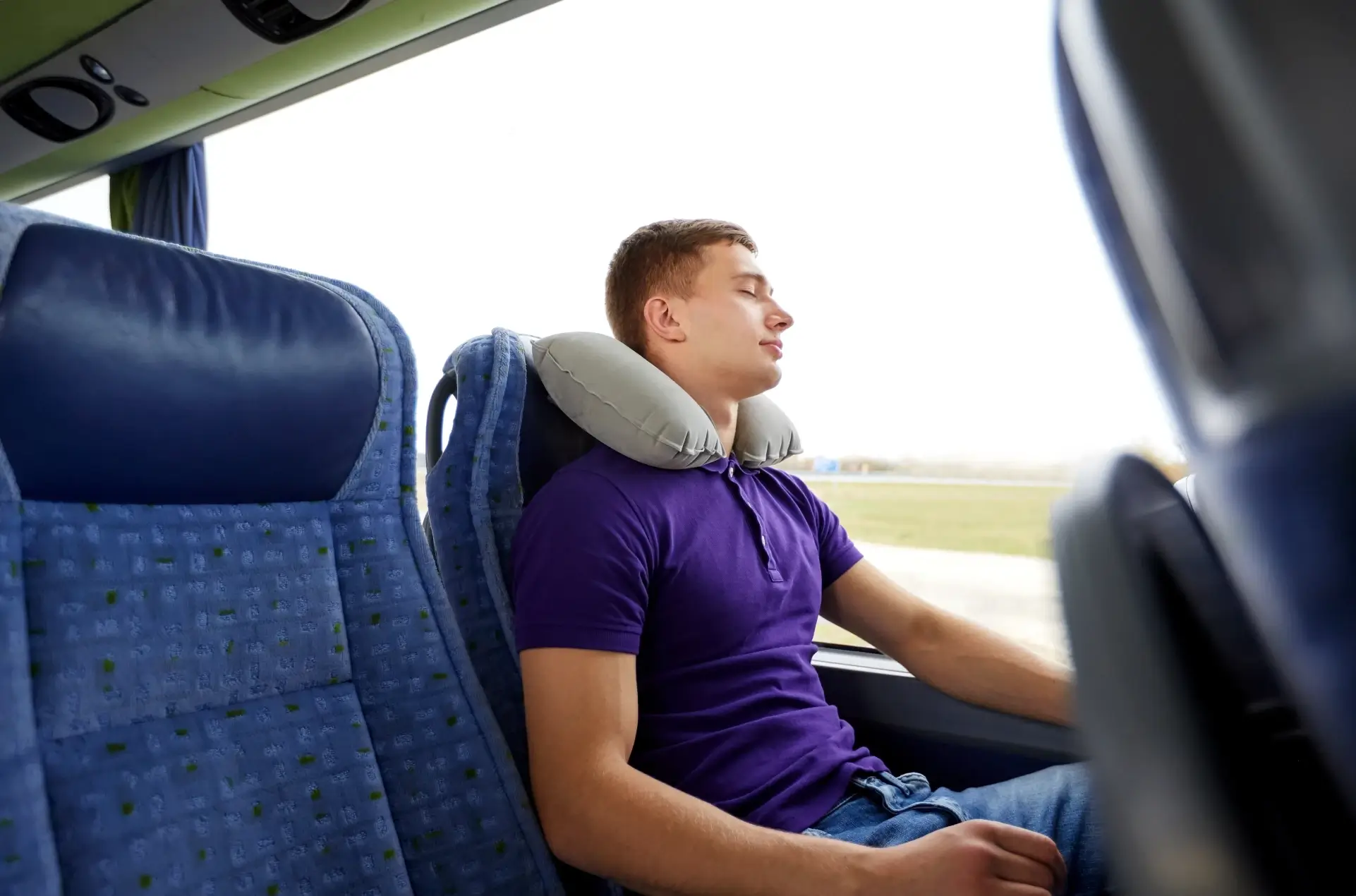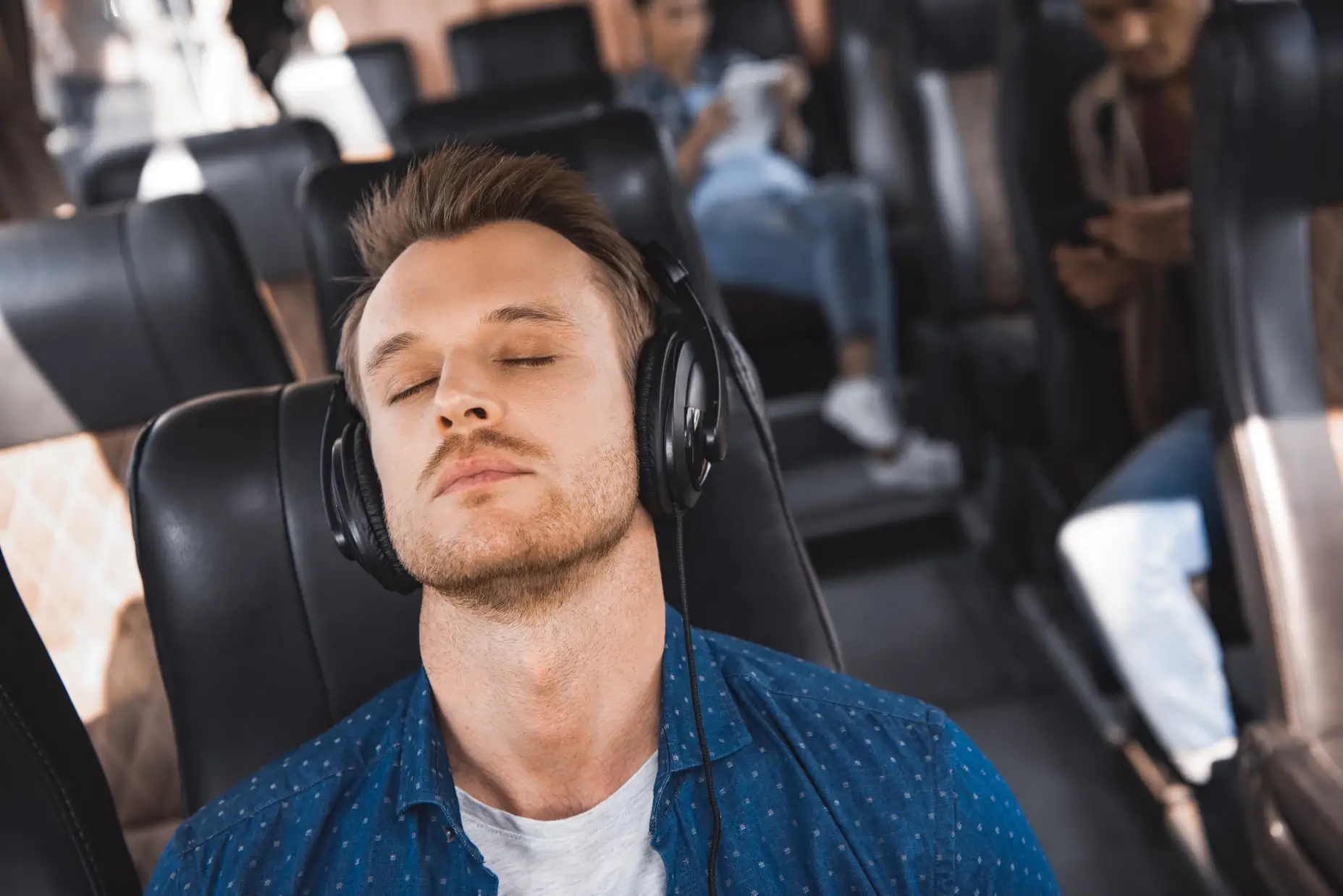Traveling by bus can be a convenient and affordable way to get from one destination to another, whether you’re catching an airport shuttle, heading to an important event, or embarking on a group tour. However, when the journey is long and sleep is a priority, getting comfortable on a moving bus can be a real challenge. Between the cramped quarters, unpredictable temperatures, and constant noise, finding a way to rest comfortably while maintaining safety is crucial for anyone seeking to arrive refreshed at their destination.
Whether you’re preparing for an overnight trip, a day-long tour, or simply trying to catch a nap during a long commute, sleeping on a bus doesn’t have to be uncomfortable or stressful. With the right preparation and strategies, you can optimize your seating choice, pack essential accessories, and take steps to ensure you get the rest you need, even in the less-than-ideal confines of a bus.
In this article, we’ll explore practical tips for making your bus journey more comfortable and ensuring you get the sleep you need while staying safe. From choosing the right seat to blocking out distractions and maintaining good sleep posture, these strategies will help you make the most of your time on the road.
Choose the Best Seat for a Comfortable Ride
Your seat choice can make or break your ability to sleep on a bus. Not every seat offers the same level of comfort, and picking the wrong one could result in a restless, uncomfortable trip. Here’s how to ensure you choose the best seat for maximum comfort:
1. Opt for a Mid-Bus Seat for Smoother Rides
The middle of the bus is often the sweet spot when it comes to avoiding bumps and jolts from the road. Sitting near the back can be noisier, and you’re likely to feel more movement as the bus maneuvers. Conversely, sitting at the very front may expose you to the bus driver’s noise and view of the road, which can be distracting. The middle provides the most stable ride, giving you the best chance at a peaceful rest.
2. Choose a Window Seat for Head Support
A window seat allows you to lean against the side of the bus, providing more stability for your head and body. This extra support can prevent your neck from straining awkwardly and reduce the chances of waking up from sudden movements. You’ll also have control over the window shade, giving you the option to block out the sun or outside lights.
3. Avoid Sitting Near High-Traffic Areas
Seats near the bathroom or close to bus exits often experience more foot traffic. People constantly walking by, opening and closing doors, or lining up for the restroom can disturb your sleep. Aim for a spot away from these areas to minimize disruptions.
4. Look for Reclining Seats
If possible, choose a seat with a reclining option. Having the ability to lean back, even slightly, can make a significant difference in your comfort. It allows you to rest your body in a more natural position, reducing strain on your lower back and neck.
By considering these factors, you can greatly improve your chances of finding a seat that makes sleeping easier, even on long or bumpy rides.

Bring Essential Sleep Accessories
Comfort on a bus often comes down to the accessories you bring with you. Packing a few simple but effective items can transform your experience from restless to restful. These essential accessories are designed to help you sleep comfortably no matter how long or short your journey is.
1. Invest in a High-Quality Travel Pillow
A travel pillow is a must-have for anyone trying to sleep on a bus. These pillows provide crucial neck support, preventing your head from drooping uncomfortably or jerking awake from a sudden movement. Look for U-shaped pillows that cradle your neck, or inflatable ones that can be easily packed and adjusted to your liking. Memory foam travel pillows offer excellent support and are highly recommended for longer trips.
2. Use an Eye Mask to Block Out Light
Bright lights inside the bus or passing headlights from outside can disturb your sleep. An eye mask will help create a dark, calming environment so you can fall asleep faster and stay asleep longer. Choose one with a soft, breathable material that won’t irritate your skin, and make sure it fits snugly without pressing too hard on your face.
3. Noise-Canceling Headphones or Earplugs
Buses are often noisy environments, with the hum of the engine, chatter from other passengers, and the occasional loud announcements. Noise-canceling headphones or earplugs can significantly reduce these distractions. Headphones with soft, cushioned ear pads can also double as a comfortable headrest. Alternatively, high-quality earplugs can drown out the noise and help you relax.
4. Portable Footrest
If you have limited legroom, a portable, adjustable footrest can make a huge difference in your comfort. Elevating your feet helps with circulation and reduces leg fatigue, which is particularly useful on long trips. These footrests can often be attached to the seat in front of you, allowing you to rest your legs comfortably.
Packing these essentials can make a world of difference when trying to sleep on a bus. With the right accessories, you can create a cozy, sleep-friendly environment that feels much closer to home than a cramped bus seat.
Wear Comfortable Clothing and Bring a Blanket
What you wear on a bus trip can directly impact your ability to get a good rest. Tight, restrictive clothing can make it hard to relax, while loose, comfortable outfits can help you settle into a restful sleep. Here are some tips on how to dress and prepare for your trip to maximize comfort.
1. Choose Loose, Breathable Clothing
Comfortable clothing is key when it comes to long trips. Opt for loose-fitting clothes made from breathable materials like cotton or linen. These fabrics allow your skin to breathe and prevent overheating. Tight jeans, fitted shirts, or stiff jackets may make it harder to find a comfortable position or lead to discomfort as you try to sleep.
2. Layer Your Clothing for Temperature Control
Buses often have unpredictable climates—one minute it could be too cold, and the next, too warm. Wearing layers allows you to easily adapt to these temperature changes. A soft cardigan or hoodie is great for keeping warm, and it can be removed if the bus gets too hot. Layering also gives you the flexibility to add or remove clothing without having to carry bulky items.
3. Bring a Blanket or a Large Scarf
While some buses may offer blankets, it’s always a good idea to bring your own. A lightweight blanket or a large scarf can provide extra warmth if the bus air conditioning is too strong. These items can also double as a pillow or headrest if needed. Choose something that’s compact and easy to fold but large enough to cover you comfortably.
4. Wear Comfortable Shoes
Though you won’t be walking much, having comfortable shoes can make a big difference. Sneakers, flats, or slip-ons are ideal for long journeys. If you prefer to take your shoes off while sleeping, bring along a pair of thick socks or slippers to keep your feet warm and clean.
5. Consider Compression Socks for Long Trips
If your bus ride is especially long, consider wearing compression socks. These can help improve blood circulation and reduce swelling in your legs, which is common during extended periods of sitting. They’re particularly helpful if you’re prone to leg cramps or discomfort during long trips.
Dressing appropriately for a bus trip ensures that you stay comfortable, warm, and relaxed, making it easier for you to fall asleep and stay asleep during the journey.
Stay Hydrated but Avoid Too Many Fluids
Staying hydrated is essential during any long journey, but managing your fluid intake carefully can help you avoid discomfort or unnecessary interruptions in your sleep. Here’s how to strike the right balance when traveling by bus:
1. Drink Water to Stay Hydrated
Dehydration can lead to fatigue, headaches, and irritability—none of which are conducive to restful sleep. It’s important to drink water throughout your trip to stay hydrated, especially if the bus is air-conditioned, as dry air can cause dehydration faster. Keep a refillable water bottle handy so you can sip as needed during the ride.
2. Avoid Drinking Too Much Before Bedtime
While staying hydrated is important, you don’t want to overdo it, especially right before trying to fall asleep. Drinking large amounts of water just before sleeping can lead to frequent bathroom trips, disrupting your rest. Aim to drink enough water early in the journey, but taper off about an hour before you plan to sleep.
3. Carry Water in a Spill-Proof Bottle
If you’re bringing water with you, choose a spill-proof bottle to avoid any accidental spills that could dampen your seat, clothes, or blanket. Bottles with a secure cap or straw design are ideal for drinking without causing a mess, even when the bus hits bumps or makes sudden stops.
4. Avoid Caffeine and Sugary Drinks
Caffeinated beverages such as coffee, soda, or energy drinks can keep you awake and make it harder to relax. It’s best to avoid caffeine for at least a few hours before you plan to sleep. Similarly, sugary drinks may give you a temporary energy boost, but can also cause a crash that leaves you feeling restless or uncomfortable. Stick to water or herbal teas to stay hydrated and relaxed.
5. Herbal Teas for Relaxation
If you enjoy a warm beverage before sleeping, consider bringing herbal tea, such as chamomile or peppermint. These caffeine-free options can help soothe and relax your body, making it easier to drift off to sleep. Just be sure to drink it well before bedtime to avoid unnecessary bathroom breaks during the night.
By maintaining a careful balance with your fluid intake, you can ensure that you stay hydrated without constantly waking up for bathroom trips, ultimately allowing for a more restful journey.
Eat Light and Healthy Snacks
What you eat before and during your bus trip can greatly affect your ability to sleep comfortably. While it’s important to keep hunger at bay, eating the wrong types of foods or overindulging can leave you feeling uncomfortable and restless. Here are some tips for managing your food intake on the bus:
1. Bring Light, Healthy Snacks
Eating light snacks like nuts, fruits, or granola bars can help maintain your energy levels and prevent hunger without making you feel overly full. Avoid greasy, heavy, or overly rich foods that can cause bloating, indigestion, or discomfort while trying to sleep.
Healthy snacks to consider:
- Almonds or mixed nuts
- Sliced fruits like apples or bananas
- Whole grain crackers or rice cakes
- Trail mix or dried fruit
2. Avoid Large or Heavy Meals Before Sleeping
Large, heavy meals can make you feel sluggish or bloated, making it difficult to relax or fall asleep. Eating a big meal before boarding the bus, or during the trip, may also lead to indigestion or heartburn, which can keep you awake. If you need to eat a full meal, opt for something light and easy to digest, such as a salad or a sandwich.
3. Stay Balanced with Your Food Choices
The key to eating well on a bus ride is balance. You want to eat enough to stay satisfied without overdoing it. Incorporate a mix of protein, healthy fats, and fiber-rich snacks to help sustain your energy without making you feel weighed down.
By managing your snack choices carefully, you can ensure that hunger doesn’t disturb your sleep while also avoiding discomfort from overeating or consuming the wrong types of food.

Use Noise-Canceling Headphones or Earplugs
A bus journey often comes with a variety of noises that can disrupt your sleep, from the hum of the engine to the chatter of other passengers or even announcements over the PA system. Blocking out these distractions is key to getting some rest, and using noise-canceling headphones or earplugs can make all the difference. Choose a pair with soft, cushioned ear pads to make them comfortable enough for extended wear.
Here are some options you can listen to while trying to sleep:
- White noise: Helps drown out external sounds and can create a calming background.
- Calming music: Opt for instrumental or ambient music that isn’t too stimulating.
- Podcasts or audiobooks: Sometimes, a soothing voice can help lull you to sleep.
Maintain Good Sleep Posture
Good sleep posture is essential when trying to sleep on a bus. Poor posture can result in discomfort, muscle strain, or even injury, making it harder to rest. By paying attention to how you position your body, you can avoid these issues and increase your chances of falling into a deep, comfortable sleep.
1. Recline Your Seat (If Possible)
If your bus seat has a reclining function, use it! Reclining slightly can make a big difference in your comfort, helping to relieve pressure on your lower back and neck. While fully reclining may not always be an option, even a slight recline can mimic a more natural sleeping position compared to sitting upright.
2. Use a Travel Pillow for Neck Support
A travel pillow is essential for maintaining proper neck alignment. Without proper support, your head may tilt awkwardly to the side or forward, leading to discomfort or waking up with a stiff neck. U-shaped neck pillows provide support on both sides, keeping your head in place and reducing the strain on your neck muscles.
3. Support Your Lower Back
Bus seats don’t always offer the best lumbar support, which can lead to back pain during long trips. If you find yourself slouching, use a small pillow or even a rolled-up sweater to support the curve of your lower back. This will help you maintain a more natural posture and reduce the strain on your spine.
4. Elevate Your Legs (If Possible)
If you have enough space, elevating your legs can improve circulation and reduce discomfort. A portable footrest or even your carry-on bag can be used to prop up your feet, allowing your legs to rest in a more comfortable position. Keeping your feet elevated also helps prevent swelling, especially on long journeys.
5. Avoid Crossed Legs
Crossing your legs might feel comfortable at first, but it can lead to poor circulation and discomfort after a while. Keeping both feet flat on the ground or slightly elevated can promote better circulation and reduce the risk of cramps or stiffness.
6. Switch Positions Occasionally
Even in the most comfortable position, sitting still for too long can lead to stiffness and discomfort. Try to shift your position occasionally to avoid cramping or soreness. Simple adjustments like changing the way you rest your head or moving your legs can help prevent stiffness and keep you more comfortable during the journey.
7. Take Pressure Off Your Back with Lumbar Support
Many buses don’t provide enough lower back support, which can make it difficult to maintain good posture. If you have space, a lumbar support pillow can make a significant difference. Alternatively, you can roll up a jacket or use a backpack to support your lower back. This helps alleviate pressure on your spine and prevents discomfort during long trips.
8. Stretch During Rest Stops
Whenever the bus stops for a break, take the opportunity to stand up, stretch, and move around. Stretching your legs, arms, and back will help you maintain flexibility and reduce stiffness, making it easier to settle back into your seat and rest.
By focusing on your posture and ensuring that your body is properly supported, you can significantly improve your comfort and ability to sleep on the bus.
Secure Your Belongings for Peace of Mind
Feeling secure about your belongings can greatly affect your ability to relax and sleep during a bus ride. The worry of someone tampering with your bags or losing valuables can keep you on edge, preventing you from falling into a restful sleep. Here are some steps you can take to ensure your belongings are safe, allowing you to rest more easily.
1. Keep Valuables Close to You
Always keep your most important items—like your phone, wallet, passport, and any other valuable belongings—in a small bag or pouch that you can keep on your person. A crossbody bag or a small backpack that fits under your seat works well. This way, you don’t have to worry about them being out of sight or vulnerable to theft.
2. Use Luggage Locks
If you’re traveling with larger bags stored under the bus or in overhead compartments, using luggage locks can add an extra layer of security. While it may not be necessary for short trips, it’s a good precaution for longer journeys, especially if you need to sleep for extended periods.
3. Attach Your Bag to Your Seat
Some travelers opt to secure their bags to their seat or to themselves using a strap or lock. This method can deter theft or prevent someone from mistakenly taking your bag during the journey. A simple carabiner clip can be used to attach your bag to your seat for extra peace of mind.
4. Use RFID Protection
For an added level of security, especially on international trips, consider using wallets or bags with RFID-blocking technology to prevent electronic theft of your credit card or passport information. This may seem like an extreme precaution, but it can help you feel more relaxed about the safety of your personal information.
5. Be Mindful of Bus Stops
During bus stops, many passengers get on and off, which can make it easier for someone to mistakenly or intentionally take your bag. Stay alert when the bus stops, and ensure your belongings are secure and accounted for before you settle back down for sleep.
By securing your belongings and keeping valuables close, you can rest easier knowing your items are safe, allowing you to focus on getting some much-needed rest.

Prepare Your Mind for Sleep
Getting into the right mental state is just as important as physical comfort when it comes to sleeping on a bus. Anxiety, excitement, or general restlessness can keep you from relaxing enough to sleep. Here are a few techniques to prepare your mind for sleep and create a calm mental environment.
1. Practice Deep Breathing
Deep breathing is a simple yet powerful technique to relax your body and mind. Focus on slow, deep breaths, inhaling through your nose and exhaling through your mouth. This helps slow your heart rate and signals to your body that it’s time to relax. Try a breathing exercise such as inhaling for four counts, holding for four, and exhaling for four to help quiet your mind.
2. Try Meditation or Visualization
If deep breathing isn’t enough to calm your mind, try meditation or visualization exercises. Meditation apps often provide guided sessions specifically for sleep, helping you focus on relaxing thoughts. Visualization, such as imagining a peaceful beach or a quiet forest, can also help divert your mind from the stresses of travel and help you fall asleep.
3. Create a Familiar Sleep Routine
Even though you’re on a bus, try to recreate some of your pre-sleep routines to signal to your body that it’s time to rest. Whether it’s listening to relaxing music, reading a few pages of a book, or sipping on herbal tea, familiar routines can help put your mind at ease.
4. Limit Stimulants Before Sleep
Stimulants such as caffeine or sugar can keep your mind active, making it difficult to wind down. Avoid these in the hours leading up to your bus trip if you plan on sleeping. Opt for decaffeinated beverages or herbal teas instead, and try to eat light meals that won’t leave you feeling too energized.
5. Manage Travel Anxiety
If you’re feeling anxious about the trip, take steps to manage that anxiety before you try to sleep. This might include checking your itinerary one last time, ensuring your belongings are secure, or doing a quick mental checklist. Once everything is in order, allow yourself to relax, knowing you’ve prepared as much as you can for a smooth journey.
6. Embrace the Bus Environment
Accepting the environment you’re in can help you mentally adjust and rest more easily. Buses aren’t always the most ideal places to sleep, but by making small adjustments to your expectations and focusing on what you can control (like your comfort and mindset), you can make the most of the situation and sleep more soundly.
By preparing your mind and creating a peaceful mental environment, you’ll be able to relax more easily and fall asleep even in the bustling surroundings of a bus.
Sleeping on a bus can be tricky, but with the right preparation, it’s possible to enjoy a restful journey. From choosing the best seat to packing essential items, these tips will help make your next bus trip more comfortable and safe. Remember to stay hydrated, take short breaks to stretch, and secure your belongings for peace of mind. Whether you’re traveling overnight or on a long day trip, following these steps ensures you arrive refreshed and ready for your destination.


